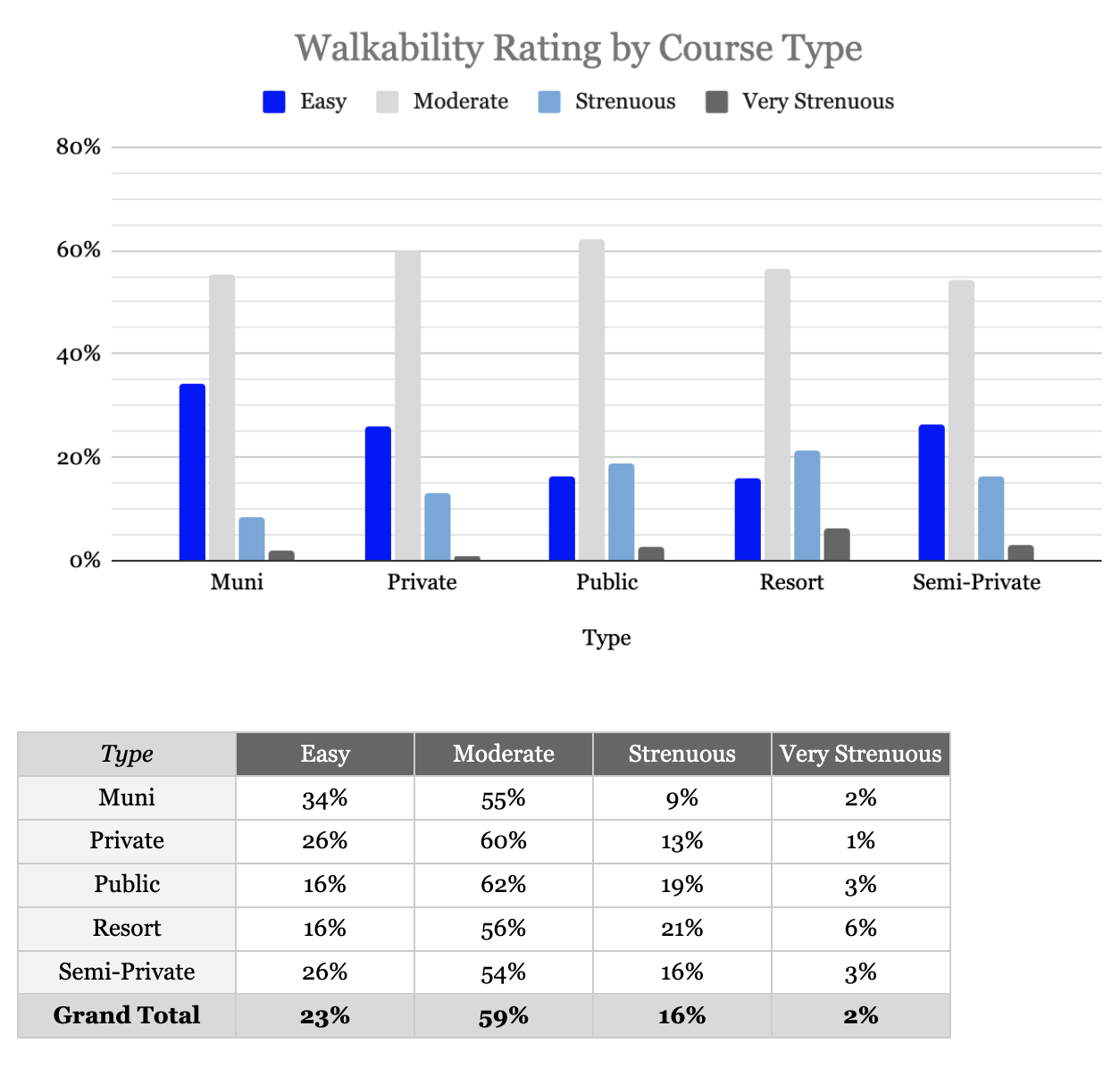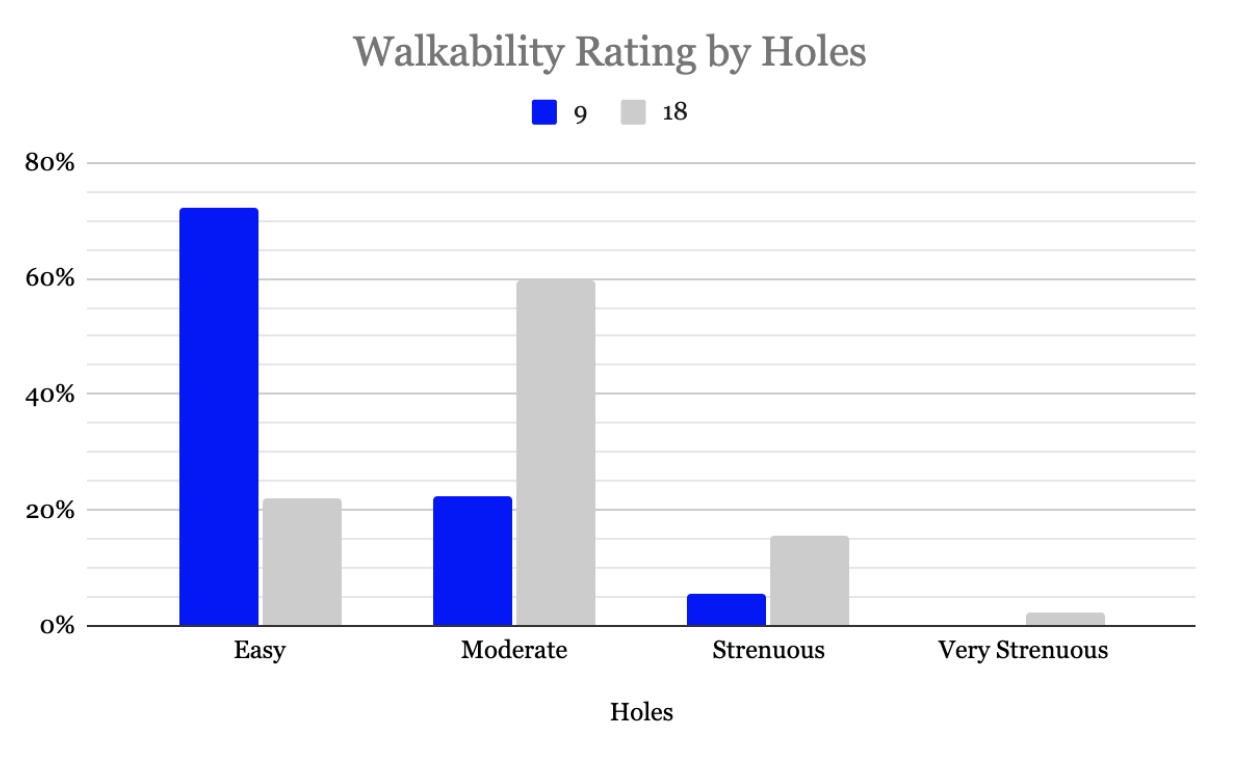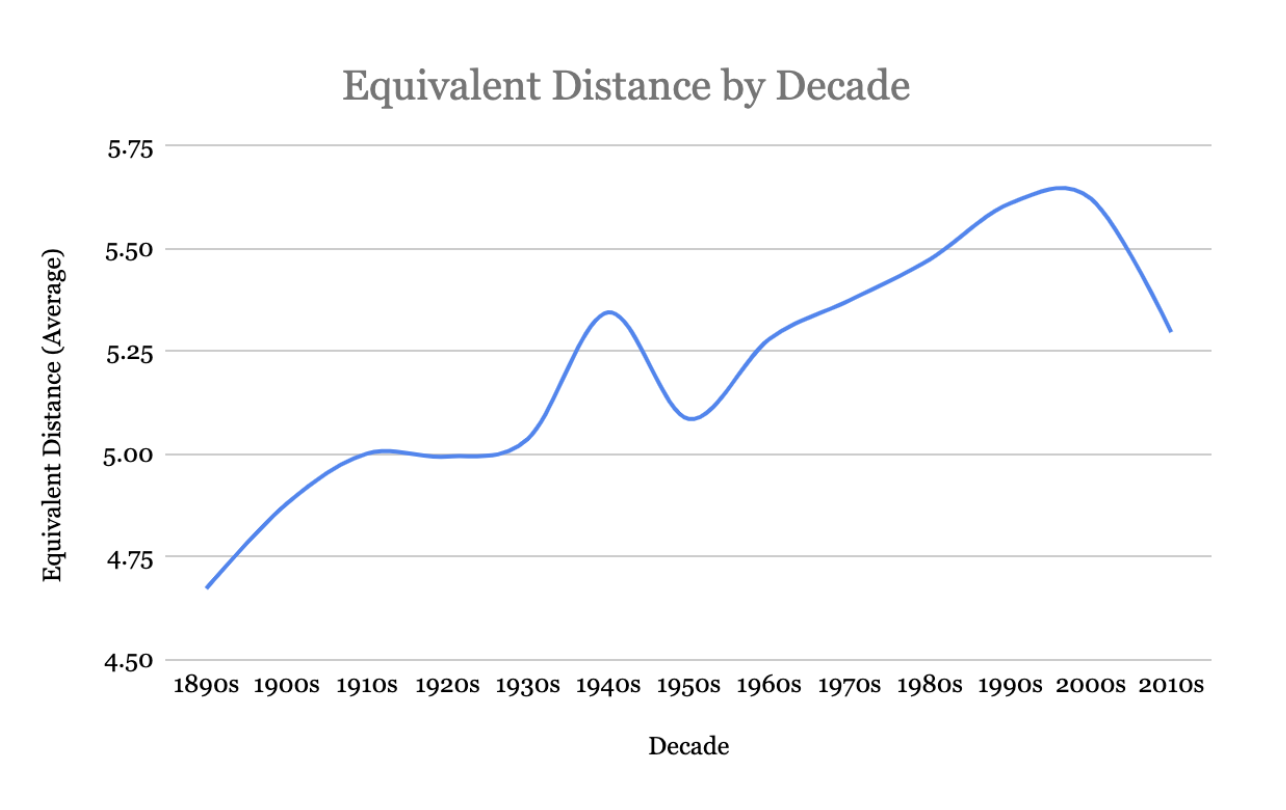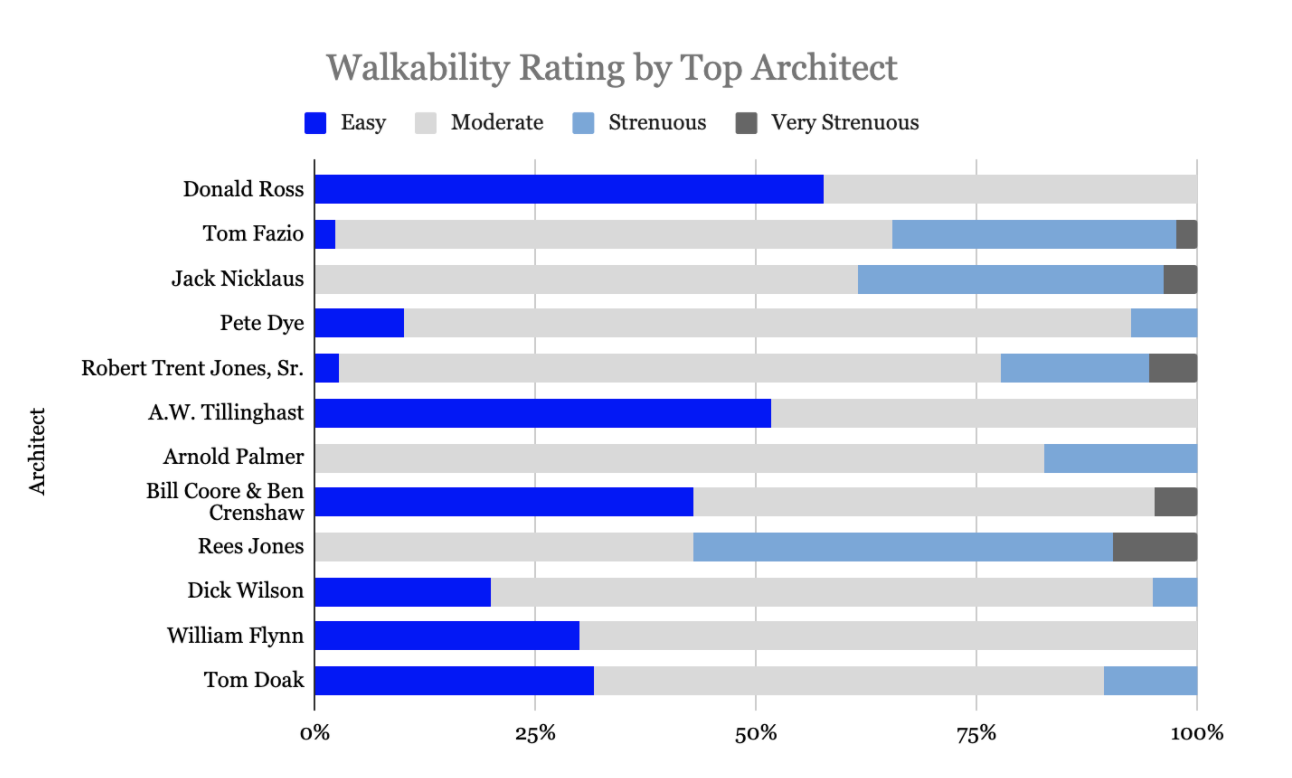Index
Open Links Walkability Ratings
At Open Links, we try to make it easy for passionate golfers to find courses based on qualities that are important to them. Many of our users prefer to experience the game on foot, whether to better connect with nature, soak in the nuances of the course, spend more time with everyone in the group, or just get more exercise. Since there is such a strong demand for walking, we have created an objective rating on our free website about how “walkable” a golf course is.
Similar to how the U.S. National Parks Service creates hiking trail difficulty ratings, we used Scarf’s Equivalence to calculate equivalent distance, which factors in horizontal and vertical distance (i.e. total ascent) and created ranges to define our categories. We partnered with ProVisualizer, a group out of the UK specializing in mapping golf courses, for the underlying data. Our formula approximates difficulty and is imperfect. The horizontal distance we used was calculated by mapping a straight line between each hole’s tee and green and adding the straight line distance between holes. However, rarely are we hitting the ball down the dead middle of the fairway. As a result, distances are underestimated.
That said, the equivalent distance calculated for different courses should be equal on a relative basis since the same golfer would be playing each course. While not perfect, we believe this is the most objective walking rating available. It is also the most comprehensive, with ratings for over 1,000 courses, and we will continue to add ratings as additional courses are mapped out by ProVisualizer.
Here are the category breakdowns and definitions:
Easy
-
Equivalent walking distance <5 miles
-
18 holes walking is generally suitable for anyone who enjoys walking. Terrain is mostly level. 36 holes walking in a day is typically suitable for anyone who wants a bit of a challenge
Moderate
-
5 miles < equivalent walking distance < 5.75 miles)
-
18 holes walking is generally suitable for anyone who wants a bit of a challenge. Terrain will involve moderate incline and may have steeper sections. 36 holes walking in a day will generally be challenging for an unconditioned person
Strenuous
-
5.75 miles < equivalent walking distance < 6.5 miles
-
18 holes walking will challenge most golfers. The walk will generally be longer and steeper. 36 holes walking in a day will challenge even the most conditioned person
Very Strenuous
-
Equivalent walking distance > 6.5 miles
-
18 holes walking will challenge even the most conditioned person and/or the course is unwalkable. The walk will generally be very steep and/or include long stretches between holes
With the introduction of our Walkability Ratings, we thought it would be interesting to break down the walking scene here in the United States. Our Walkability Ratings are available to anyone for free on our <website>, so we encourage you to take a look. We hope that these ratings will be helpful when determining where to play or whether or not you’ll be able to walk 18 (or 36 holes).
Course Info
Type
We categorize courses into five types, based on ownership and accessibility: Muni, Public, Resort, Semi-Private, and Private. Munis were the easiest to walk and Resorts were hardest. It was also interesting to see that 9-hole courses were much easier to walk than 18-hole courses. We doubled equivalent distances for 9-hole courses to make an “apples to apples” comparison with 18-hole courses.


Location
Region
For our analysis, we broke the country up into regions based on the U.S. Bureau of Economic Analysis regions:
-
Great Lakes (IL, IN, MI, MN, OH, WI)
-
Mid-Atlantic (DE, DC, MD, PA, VA, WV)
-
New England (ME, MA, NH, RI, VT)
-
Pacific Northwest (AK, WA, OR)
-
Plains (IA, KS, MO, NE, ND, SD)
-
Rocky Mountain (CO, ID, MT, UT, WY)
-
Southeast (AL, AR, FL, GA, KY, LA, MS, NC, SC, TN)
-
Southwest (NM, OK, TX)
-
Tri-State (CT, NJ, NY)
-
Western-Pacific (AZ, CA, HI, NV)
The Tri-State, New England and Great Lakes regions had the highest percentage of Easy and Moderate ranked courses. On the flip side, the Rocky Mountain region had by far the highest percentage of Strenuous and Very Strenuous ranked courses. Looking at Equivalent Distance (in miles), the courses with a Walkability Rating in the Rocky Mountains were almost one mile longer than courses in New England.

We also created our own regions here at Open Links, which were curated based on areas that made logistical sense for a multi-day golf trip. If one wanted to take a trip to a course that was generally easiest to walk, the Northern Appalachians, Coastal Maine and SE New Hampshire, Rhode Island and Cape Cod, Western Oregon and Southern Louisiana and Mississippi Gulf Coast all had the lowest Equivalent Distances.
State/Metro
Eight states had an Easy and Moderate combo at 100%, but Maine and Rhode Island had the highest percentage of Easy ranked courses, at 75%. New Hampshire had an average Equivalent Distance of 4.08 miles, which was the lowest state, and Utah had an average Equivalent Distance of 5.92 miles, the highest of any state in the U.S. Colorado, Montana, West Virginia, Alabama, Nevada, and Utah all had Equivalent Distances above 5.75 miles.
We also have Metro designations in the Open Links database, which are defined as the closest major city (or town). Since there are nearly 250 Metros in our database, we filtered out any that did not have at least 5 Walkability Ratings. There were 30 Metros tied with an Easy and Moderate combo at 100%, but Bandon Oregon had the lowest Equivalent Distance average, at 4.35 miles. Barnstable (Cape Cod) had the second-lowest at 4.68 miles. Boston, Providence, and Southampton (Eastern Long Island) were all under 5 miles. Athens (GA) had the highest Equivalent Distance of any Metro with atleast 5 Walkability Ratings, at 6.13 miles. Tucson, Reno and Atlanta (North) were all above 5.75 miles.
Architecture
Era/Decade
The average Equivalent Distance of courses built prior to 1960 (i.e. Classic) is half a mile shorter than those built after 1960 (i.e. Modern), 5.0 miles compared to 5.51 miles. This probably isn’t surprising as the enhancements to the golf ball have required newer courses to be longer. Interestingly, the Equivalent Distance of courses built in the latest decade (the 2010s) was the lowest since the 1960s. This will be an interesting trend to keep an eye on in the 2020s.

Architect
There is such a difference in each era, we thought it made more sense to compare Golf Course Architects from the same era. There are 275 different Architects with Walkability Ratings but we filtered out any who did not have at least 5 to whittle down the list. As far as Architects from the Classic era go, Wayne Stiles had the lowest average Equivalent Distance with 4.53 miles. Seth Raynor came in 2nd lowest at 4.8 miles, followed by Devereux Emmet (4.85), Walter Travis (4.91), and Alister Mackenzie (4.94). The highest Classic Architect was George Thomas, who had an average Equivalent Distance of 5.29 miles; however, a few of his designs have recently been lengthened to host professional events. Robert Trent Jones, Sr., who had many designs in both eras, came in at 5.49 miles.
Gil Hanse had the lowest average Equivalent Distance amongst the Modern Architects, at 4.82 miles. He was followed by Ken Dye at 4.97 miles, Bill Coore & Ben Crenshaw (4.97), and Tom Doak (5.24). Arthur Hills had the highest amongst Modern Architects, with an average Equivalent Distance of 5.89 miles, or over 1 mile longer than Gil Hanse. Rees Jones (5.87 miles), Greg Norman (5.78), Jack Nicklaus (5.7), and Tom Fazio (5.6) rounded out the top-5 highest.
Here is a breakdown of Walkability Rating for the Architects with the most ratings in our database:

Additional Factors Worth Considering
-
The average slope rating from the back tees for courses with Walkability Ratings: Easy (132), Moderate (140), Strenuous (142), Very Strenuous (141)
-
The average Equivalent Distance for ranked courses (Golf Digest Top 200, Golf Magazine Top 100, Golfweek Top 200 Classic and Golfweek Top 200 Modern) was the same as unranked courses, at 5.33 miles
-
Residential courses (i.e. courses with housing) were 0.27 miles longer than courses with no housing. Please see our Housing Index breakdown for more information
-
The course at the highest elevation that is easiest to walk is Teton Pines near Jackson Wyoming, with an elevation of 6,204 feet and an Equivalent Distance of 5.07 miles. The average Equivalent Distance for courses above 5,000 feet elevation is 5.75 miles
-
The following courses have Moderate Walkability Ratings but do not allow walking: Cowboys GC, Giants Ridge (Quarry), Half Moon Bay (Old), Hammock Beach (Ocean), Mission Inn (El Campeon), Old Corkscrew, Shadow Ridge and Ventana Canyon (Mountain). We’d love to see these courses offer golfers the option to enjoy the course on foot
